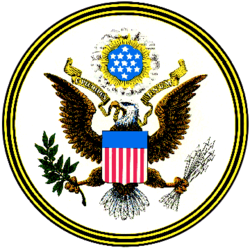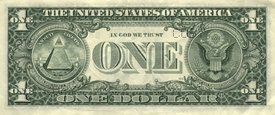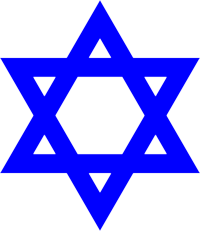Star of David
|
|
The Star of David (Magen David in Hebrew or Mogen Dovid in Ashkenazi Hebrew, Shield of David, Solomon's Seal, or Seal of Solomon) is a generally recognized symbol of Judaism and Jewish identity. It is also known colloquially as the Jewish Star. With the establishment of the State of Israel the Jewish Star on the flag of Israel has also become a symbol of Israel.
| Contents |
Origin
The shield of David is not mentioned in rabbinic literature. Notably, not a single archeological proof exists as yet concerning the use of this symbol in the Holy Land in ancient times, even after King David. A David's shield has recently been noted on a Jewish tombstone at Taranto, in Southern Italy, which may date as early as the third century of the common era. The earliest Jewish literary source which mentions it, the Eshkol ha-Kofer of the Karaite Judah Hadassi (middle of the 12th cent.), says, in ch. 242: "Seven names of angels precede the mezuzah: Michael, Gabriel, etc.... Tetragrammaton protect thee! And likewise the sign called 'David's shield' is placed beside the name of each angel." It was, therefore, at this time a sign on amulets.
In magic papyri of antiquity, pentagrams, together with stars and other signs, are frequently found on amulets bearing the Jewish names of God, and used to guard against fever and other diseases. Curiously enough, only the pentacle appears, not the hexagram. In the great magic papyrus at Paris and London there are twenty-two signs side by side, and a circle with twelve signs, but neither a pentacle nor a hexagram. The syncretism of Hellenistic, Jewish, and Coptic influences probably did not, therefore, originate the symbol. It is possible that it was the Kabbalah that derived the symbol from the Templars. Kabbalah makes use of this sign, arranging the Ten Sephiroth, or spheres, in it, and placing it on amulets.
A manuscript Tanakh dated 1307 and belonging to Rabbi Yosef bar Yehuda ben Marvas from Toledo, Spain, was decorated with a Shield of David.
In the synagogues, perhaps, it took the place of the mezuzah, and the name "shield of David" may have been given it in virtue of its presumed protective powers. The hexagram may have been employed originally also as an architectural ornament on synagogues, as it is, for example, on the cathedrals of Brandenburg and Stendal, and on the Marktkirche at Hanover. A pentacle in this form is found on the ancient synagogue at Tell Hum.
In 1354, King of Bohemia Charles IV prescribed for the Jews of Prague a red flag with both David's shield and Solomon's seal, while the red flag with which the Jews met King Matthias of Hungary in the 15th century showed two pentacles with two golden stars (Schwandtner, Scriptores Rerum Hungaricarum, ii. 148). The pentacle, therefore, may also have been used among the Jews. It occurs in a manuscript as early as the year 1073 (facsimile in M. Friedmann, Seder Eliyahu Rabbah ve-Seder Eliyahu Ztṭa, Vienna, 1901).
In 1460, the Jews of Ofen (Budapest, Hungary) received King Mathios Kuruvenus with a red flag on which were two Shields of David and two stars. In the first Hebrew prayer book, printed in Prague in 1512, a large Shield of David appears on the cover. In the colophon is written: "Each man beneath his flag according to the house of their fathers... and he will merit to bestow a bountiful gift on anyone who grasps the Shield of David." In 1592, Mordechai Maizel was allowed to affix "a flag of King David, similar to that located on the Main Synagogue" to his synagogue in Prague. In 1648, the Jews of Prague were again allowed a flag, in acknowledgment of their part in defending the city against the Swedes. On a red background was a yellow Shield of David, in the centre of which was a Swedish star. (Source: [1] (http://www.mfa.gov.il/MFA/MFAArchive/1990_1999/1999/1/Reuven%20Kashani%20-%20The%20National%20Flag))
Jewish lore links the symbol to the "Seal of Solomon", the magical signet ring used by King Solomon to control demons and spirits. Jewish lore also links the symbol to a magic shield owned by King David that protected him from enemies. Following Jewish emancipation after the French revolution, Jewish communities chose the Star of David to represent themselves, comparable to the cross used by most Christians. The star is found on the flag of Israel.
The shape of the star is an example of the hexagram, a symbol which has significance for other belief systems. The hexagram pre-dates its use by Jews. Its most prevalent usage outside of Judaism was and is the occult.

Some Orthodox Jewish groups reject the use of the hexagram because of its association with "magic" and the "occult". Yet the Star of David remains an important symbol within legitimate Jewish mysticism and the Kabbala. Some Haredi groups, such as Neturei Karta, reject it because of its association with Zionism. Many Modern Orthodox synagogues, and many synagogues of other Jewish movements, have the Israeli flag with the Star of David prominently displayed at the front of the synagogues near the Ark containing the Torah scrolls. The Star of David can also be found on the tombstones of religious Jews going back hundreds of years in Europe as it became accepted as the universal symbol of the Jewish people.
Some researchers have theorized that the Star of David represents the astrological chart at the time of David's birth or anointing as king. The Star of David is also known as the "King's Star" in astrological circles, and was undoubtedly an important astrological symbol in Zoroastrianism.
Prof. Gershom Sholem theorizes that the "Star of David" originates in the writings of Aristotle, who used triangles in different positions to indicate the different basic elements. The superposed triangles thus represented combinations of those elements. From Aristotle's writings those symbols made their ways into early, pre-moslem, Arab literature. The Arabs were very interested in arithmetics, and were also very strongly drawn to occult and demonic tales. In fact, one of the most important personae in early Arab literature was King Salomon (Suliman). The Babylonian Talmud contains a legend about King Salomon being kidnapped by Ashmedai, the king of demons. He succeeded in kidnapping the king by stealing his "seal of Salomon" - (Arabic - Hattam Soliman), although according to the Talmud this seal was simply a metal coin with hebrew letters meaning the name of God, inscribed on it. It is possible that the seal was altered in the Arab tales. The first apparition of the symbol in Jewish scriptures was in oriental Kabbalistic writings, so it is possible that it was an alteration of the pentagram under Arab influence. Early Jewish sybols include the Shofar ("ram's horn"), Lulav ("shoot of palm"), and the seven-branch Menorah ("candelabra"), but no hexagram is found in early Jewish sybolism.
Abuse of the Star of David by the Nazis
A Star of David, often yellow-colored, was used by the Nazis, during the Holocaust, as a method of identifying Jews, as it was seen as the "Jewish Star". The requirement to wear the Star of David with the word Jude (German for Jew) inscribed, was extended to all Jews over the age of 6 in German-occupied areas on September 6, 1941. In other areas, local words were used (e.g. Juif in French, Jood in Dutch). In occupied Poland Jews were forced to wear a white armband with a blue Star of David on it, as well as a patch on the front and back of their clothing.
Jewish inmates in concentration camps were later forced to wear similar Nazi concentration camp badges.
See also: Yellow badge
Other uses
On the Great Seal of the United States

Curiously, the Great Seal of the United States appears to contain an image of a Star of David. At the top of the obverse side of the Great Seal is a cluster of thirteen stars shaped in a very obvious "Star of David" shape, consisting of 13 smaller American Stars probably symbolizing the 13 original colonies, above the eagle's head. This image is also found on the reverse side of the U.S. one dollar bill. No-one is absolutely sure today why that is so. Some historians think it was a way of showing gratitude to Haym Solomon (1740-1785) who was Jewish and is acknowledged as the prime financier of the American side during the American Revolution and the American Revolutionary War of 1776, which many are not aware of. Some maintain Solomon designed the great seal himself.

Another reason has been postulated that perhaps it was a way of the Founding Fathers of the United States acknowledging the God of the Hebrew Bible because of their strong devotion to the "Old Testament" as a guide to life. Others have seen more sinister reasons that actually border on anti-Semitic conspiracy theories.
Whatever, the reasons may be, there is no question, that the shape of the Star of David is clearly emblazoned on the US' Great Seal and on all US one dollar bills today.
Latter-day Saints (Mormons)
Salt_Lake_Assembly_Hall_Star_of_David.jpg
The Star of David is also used less prominently by The Church of Jesus Christ of Latter-day Saints, chiefly in architecture. It symbolizes the Tribes of Israel and friendship and affinity towards the Jewish people. Additionally, some independent LDS theologians such as Jewish-LDS Daniel Rona have further suggested the possibility that the Star of David was actually modeled after the Urim and Thummim, but this is not official doctrine of the Church.
Raelism
Raelism uses a symbol inspired by the Star of David. The symbol initially chosen by Claude Vorilhon for his movement was the source of considerable controversy: it resembled a Star of David with the image of a swastika embedded in its center. According to official Raelian statements, the swastika "represents infinity of time, and trace its origins to Sanskrit and Buddhist symbols, to the Chinese character for temple, and to ancient catacombs, mosques, and synagogues."
Rael_symbol.JPG
In 1991, the symbol was changed to remove the swastika and deflect public criticism, as well as to gain acceptance in Israel for the building of a Raelian "embassy" to greet anticipated Elohim space vessels.
See also
Notes
- There is a plant named Solomon's seal Polygonatum multiflorum in the lily family.
- In Unicode, the "Star of David" symbol is U+2721 (✡).
External links
- Hexagram -- from MathWorld (http://mathworld.wolfram.com/Hexagram.html)
- Avram Yehoshua's information on the star's use in modern Israel (http://www.seedofabraham.net/stardavd.html)cs:Davidova hvězda
de:Davidstern he:מגן דוד ko:다윗의 별 nl:Davidster ja:ダビデの星 pl:Gwiazda Dawida zh:大衛星


